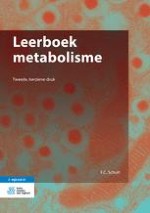Gepubliceerd in:
2015 | OriginalPaper | Hoofdstuk
3. Glycolyse
Samenvatting
Hoofdstuk 3 bespreekt de glycolyse, de splitsing van glucose in twee moleculen pyruvaat. Deze weg wordt voorafgegaan door opname van glucose via glucosetransporters: eiwitkanaaltjes in de celmembraan. De glycolyse verloopt in tien, door specifieke enzymen gekatalyseerde, reacties die in drie fasen kunnen worden onderverdeeld. Tijdens de eerste fase worden twee ATP geïnvesteerd en ontstaat uit glucose het fructose-1,6-bisfosfaat. In de tweede fase wordt fructose-1,6-bisfosfaat omgezet in twee glyceraldehyde-3-fosfaat, die in de derde fase worden gemetaboliseerd tot twee moleculen pyruvaat (netto winst 2ATP). Pyruvaat kan in de mitochondria verder worden geoxideerd tot CO2, maar bij gebrek aan zuurstof wordt pyruvaat gereduceerd tot lactaat (anaerobe glycolyse). Een afgeleide van de glycolyse, het 2,3-bisfosfoglyceraat, regelt de zuurstofafgifte door rode bloedcellen aan de weefsels. De glycolyse is niet alleen katabool, maar sluit ook aan op anabole paden, zoals de pentosefosfaatweg en de vetzuursynthese. Regeling van de glycolytische flux gebeurt via fructose-2,6-bisfosfaat, dat fosfofructokinase-1 activeert.
